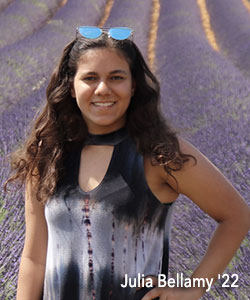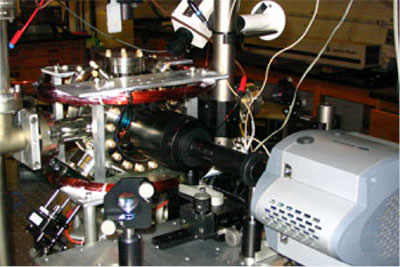Physics Department
Undergraduate Research
Encouraging and enabling student achievements is one of our primary goals at HWS. In the Physics Department, our students have opportunities to engage in Honors projects and independent studies that require students to actively engage in research.
A recent sampling of research:
Biruk Nardos Abebe ’25: Interior Structure Modeling of Sub-Neptune Exoplanets: From TOI-270d ti Population-Level Influence
Leslie Hebb, Adviser
Misty Tze Yun Chien '23: Identifying Kepler/K2 objects with Starspot Crossing Characteristics
Leslie Hebb, Adviser
Katelin Crabtree '22: Detecting coronal mass ejections on other stars
Leslie Hebb, Adviser

"This intensive honors experience was a lot of hard work, but I would do it all again because being able to propose, develop, design, and carry out my own independent research and follow through to a successful end goal has been invaluable." - Julia Bellamy '22, BE '23, member of the HWS-Dartmouth Engineering Program
Julia Bellamy '22: Image Analysis for Detecting Harmful Algae Bloom in the Finger Lakes
Ileana Dumitriu, Adviser
Joshua N. Andrews ’20: Remote Sensing through the Use of Consumer Drones: Harmful Algae Blooms in the Finger Lakes Region of New York State
Ileana Dumitriu, Adviser
Jasper White '20: Portable hydroelectric: generating energy in remote locations
Ileana Dumitri, Adviser
Max Brodheim ’20: Masses and Radii of MML 48: A New Pre-Main Sequence Eclipsing Binary
Leslie Hebb, Adviser
Magdy Gad ’19: Developing Detection of Blue Green Algae Using Drones Outfitted with Spectrometers
Ileana Dumitriu, Adviser
Scott Calnan ’17: Harvesting Wave Energy by Modifying the Anchor to Nautical Navigation Aids
Ileana Dumitriu, Adviser
Christopher Demas ’17: Modeling Algae Concentrations via Reflectance Spectroscopy for Remote Sensing
Ileana Dumitriu, Adviser
Tyler Hanzlik ’17: Levitation with Superconducting Electromagnets
Ileana Dumitriu, Adviser
Michelle Gomez '16: Starspot crossing transits in long-cadence Kepler data: a search for correlations between starspots and stellar properties
Leslie Hebb, Adviser
Faculty Research

TED ALLEN, PROFESSOR
My research interests are in the general area of theoretical particle physics and gravitation. The two most prominent themes of my current research are QCD Strings and Constrained Quantization.
Quantum Chromodynamic Strings
Lattice calculations show that while the color force binding together a quark and an anti-quark behaves much like the electromagnetic force on very small scales, the color flux coalesces into a string-like object when the quark separation becomes appreciable on the nuclear scale. Mechanically, such a bound system acts like two point masses connected by a cord of energy. This cord, or string, can vibrate and the system can behave in more complicated and interesting ways than, say, a hydrogen atom. A while ago my collaborators and I found a model of this string and the quarks it connects that also incorporates the spin of the quarks. I am currently working to construct the quantum mechanics of this system.
Constrained Mechanical Systems and their Quantization
Most fundamental theories of physics have continuous symmetries that make their description of the physics redundant; they are constrained systems. The quantum mechanics of these systems must take these symmetries into account. I am interested in constructing new tools and applying existing tools to construct the quantum mechanics of constrained systems.
Other research interests of mine are the relationship between gravity, quantum mechanics, and thermodynamics; vortex dynamics and the fractional quantum Hall effect; potential models for quark confinement; and topological mass mechanisms.
Steve Penn, Associate Professor
My research is in gravitational wave astrophysics. The potential for gravitational wave astrophysics is best summarized by a recent quote from the National Academy’s Decadal Survey on Astronomy and Astrophysics 2020.
"Gravitational wave astrophysics is one of the most exciting frontiers in science. One of the survey’s key priorities is the opening of new windows on the dynamic universe, with gravitational wave detection at the forefront. The continued growth in sensitivity of current-generation facilities, such as LIGO, through phased upgrades and planning the next-generation observatory, such as Cosmic Explorer, is essential. This will require investment in technology development now. The survey committee strongly endorses gravitational wave observations as central to many crucial science objectives." [Emphasis mine.]
Therefore, during these early years of Gravitational Wave Astrophysics, the fastest means to grow this field is by increasing the detector sensitivity, which increases the event rate and the SNR. For the LIGO detector, the most promising and practical path for maximizing its sensitiv- ity is through the reduction of 3 main noises sources: Suspension thermal noise, Laser quantum noise, and Coating thermal noise.
I was on the research team that first measured LIGO's Coating Thermal Noise. that determined the source of the noise, and that developed the mirror coating for Advanced LIGO (which detected gravitational waves). My current research is on crystalline GaAs/AlGaAs mirror coatings that have 10x lower noise than the Advanced LIGO coatings.
DONALD SPECTOR, PROFESSOR

My research is multi-faceted, generally focusing particle theory and mathematical physics, with opportunities for involvement by interested students. Two current areas of my work that explore ideas relevant to quantum field theory and string theory are as follows:
- Developing a geometric characterization of shape invariance. Shape invariance is the principle underlying quantum systems that can be solved completely. Having previously showed that shape invariance is based on a BPS structure, an algebraic phenomenon known from the study of monopoles and strings, I am now aiming to use flux quantization to provide a geometrical formulation of the BPS interpretation of shape invariance, so that we know why this BPS structure appears.
- Is the Hagedorn temperature a fundamental limit? String theory appears to have a maximum possible temperature, termed the Hagedorn temperature. My work on number theory and supersymmetry has identified a whole class of additional models that also possess a Hagedorn temperature. In these models, I am examining whether this temperature is a fundamental physical limit or an artifact of the mathematical formulation. Preliminary evidence suggests that Hagedorn temperature might be an artifact that reflects the presence of a hidden sector of particles, whose interaction with ordinary matter only becomes relevant at high energies.
Other areas in which I have an interest include analog algorithms in quantum computing, cooling schedules in simulated annealing, the bosonic decay of Q-balls, the engineering of quantum potentials to produce logarithmic spectra, the use of first-order phase transitions to model phenomena in computer science, economics, and biology, and anything to do with supersymmetry.
Student Prizes
Albert Holland Prize for Public Presentations of Physics
The annual Albert Holland Prize is awarded to the winner of a competition for the best public presentation in physics by a student. Students present a short 15-minute talk on a standard result in physics. They are judged based on the quality of their scientific content and the quality of their rhetorical skill. The winner receives a $500 prize.
The competition is always judged by three faculty members – one from the physics department, one from the English department, and one from another department.
Albert Edward Holland, for whom the prize is named, was president of the Colleges from 1966 to 1968. He was known for his vision, honesty, integrity and his remarkable skills in public presentation. He received a letter of commendation from the U.S. government for employing those skills in helping to save those imprisoned with him in a Japanese prison camp in the Philippines during World War II. While president of the Colleges, he was responsible for the establishment of Geneva Scholars Associates, which provides scholarship aid to students from the Geneva area.
Other Awards
Two awards are presented annually on both Charter Day and at the Ben Hale Dinner; the Outstanding Physics Major Prize ($100 is given) and the Physics Prize for First Year Students (a book is given).
